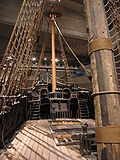Gallery
- Taffrail (#1)
- William Heysmann Overend painting: Naval Captain on the Poop deck taffrail
- Weather deck of the Swedish 17th-century warship Vasa looking aft toward the sterncastle, with a hand carved taffrail
- Gdańsk "Lew" a seventeenth century galleon replica, stern with wooden carved taffrail
- Prins Willem stern with wooden carved taffrail
- Star of India stern taffrail





